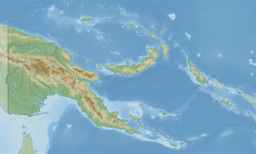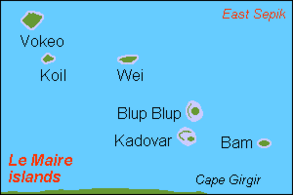Kadovar
Topic: Earth
 From HandWiki - Reading time: 3 min
From HandWiki - Reading time: 3 min
| Kadovar Island | |
|---|---|
| Highest point | |
| Elevation | 365 m (1,198 ft) |
| Coordinates | [ ⚑ ] : 3°36′32″S 144°35′18″E / 3.60889°S 144.58833°E |
| Geography | |
| Location | Papua New Guinea |
| Geology | |
| Age of rock | Holocene |
| Mountain type | Stratovolcano |
| Volcanic arc | western end of the Bismarck volcanic arc[1] |
| Last eruption | 2018-ongoing |
Kadovar is a volcanic island in Papua New Guinea northeast of the much larger island of New Guinea. The volcano erupted in January 2018 and the eruption is ongoing as of 2023, although the activity level is generally considered to be low.[2] There were some heightened thermal phenomena in 1976.[2]
Geography
Kadovar is part of the Schouten Islands about 25 kilometres (15 mi) north of the mouth of the Sepik River. It is 1.5 km (0.9 mi) long and wide. The village of Gewai is near the crater rim. Authorities had thought around 700 people lived on the island, but this number was related to the registered voters on the island and the actual number was found to be much higher during a re-settlement ordered after the volcano erupted in January 2018.[3][4]
History
The first recorded sighting by Europeans of Kadovar was by the Spanish navigator Yñigo Ortiz de Retez on 21 July 1545 when on board the carrack San Juan trying to return from Tidore to New Spain.[5]
In 1700 smoke was reported, possibly from an eruption. There were further indications of possible imminent eruptions in 1976 and 1981. The island's inhabitants were evacuated to the nearby island of Blup Blup in 1976.[6]
2018 eruption
The island was again evacuated by boats and canoes immediately after an eruption began on 5 January 2018 that lasted several days and resulted in at least half of the island being covered in lava.[7] The Rabaul Volcanological Observatory described "mild vulcanian activity from a vent at the southeast base of the cumulodome" and that "a fissure may be opening just inside of the western wall of the vent’s breach, descending down to at least sea level".[8] According to the Australian bureau of the Volcanic Ash Advisory Center in Darwin, the ash cloud formed a plume as high as 7,000 feet (2,100 m).[9]
See also
- List of volcanoes in Papua New Guinea
References
- ↑ Llanes, P.; Silver, E.; Day, S.; Hoffman, G. (2009). "Interactions between a transform fault and arc volcanism in the Bismarck Sea, Papua New Guinea". Geochemistry, Geophysics, Geosystems 10 (6): n/a. doi:10.1029/2009GC002430. Bibcode: 2009GGG....10.6013L. https://eprints.ucm.es/id/eprint/77160/1/Geochem%20Geophys%20Geosyst%20-%202009%20-%20Llanes%20-%20Interactions%20between%20a%20transform%20fault%20and%20arc%20volcanism%20in%20the%20Bismarck%20Sea%20.pdf.
- ↑ 2.0 2.1 "Kadovar". Smithsonian Institution. https://volcano.si.edu/volcano.cfm?vnum=251002.
- ↑ "eruption 2018". 6 January 2018. http://www.looppng.com/png-news/kadovar-eruption-sleeping-volcano-awakes-71907.
- ↑ "PNG volcano: Authorities to resettle 2,000 evacuees on mainland as island volcano erupts". ABC News Australia. 2018-01-10. http://www.abc.net.au/news/2018-01-10/png-volcano-eruption-sparks-mass-resettlement-exercise/9318548.
- ↑ Coello, Francisco "Conflicto hispano-alemán" Boletín de Sociedad Geográfica de Madrid, t.XIX. 2º semestre 1885, Madrid, p.317.
- ↑ "Kadovar volcano". Volcano Discovery. https://www.volcanodiscovery.com/kadovar.html.
- ↑ "First known eruption of Kadovar volcano in Papua New Guinea prompts evacuation of 500 people after sending a column of ash 7000 feet in the air". January 6, 2018. http://strangesounds.org/2018/01/kadovar-volcano-first-known-eruption-papua-new-guinea-evacuation-picture-video.html.
- ↑ "Smoke And Ash Engulf The Sky As Dormant Kadovar Volcano Erupts In PNG". http://www.carbonated.tv/viral/dormant-papua-new-guinea-volcano-kadovar-erupts-forces-evacuation.
- ↑ Hughes, Amani (8 January 2018). "Papua New Guinea volcano latest: Is Mount Kadovar erupting? Will it erupt again?". Express Newspapers. https://www.express.co.uk/news/world/901893/Volcano-Papua-New-Guinea-Mount-Kadovar-eruption-will-it-erupt-again-evacuation-latest.
 |
 KSF
KSF

